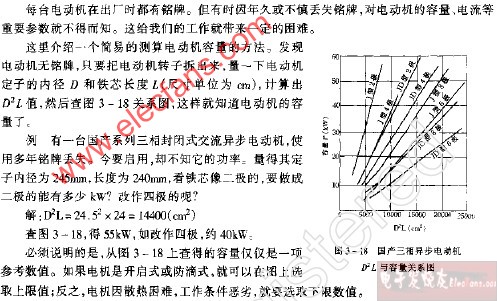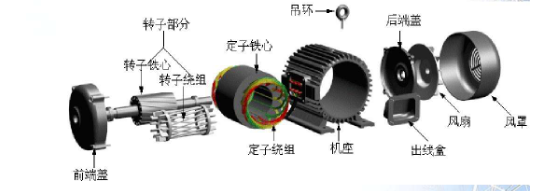教学目标
了解电动机容量选择的基本理论。
掌握电力拖动系统中电动机容量选择的工程方法 。
5.1 The choice of Motor
There are many factors which must be considered when choosing a motor for a particular drive. In the following notes, the main points are highlighted but the final choice is usually a matter for the specialist. Not all the factors can be dealt with here, but the summary notes, together with the relevant sections of the main text, will be sufficient to give a good appreciation of the general problem.
The solution of this problem is not usually unique and opinions may differ widely in some cases as to he most suitable motor-drive system. However, it may be said in brief that the correct motor is the one which meets the required specification at minimum cost, but this is not a simple matter to estimate. It must include not only the capital cost of the motor-drive system itself but also the running costs. The capital cost includes the provision of any special supplies find control gear to run the motor.
The running cost includes interest, charges on capital equipment and buildings and charges for the power losses consumed in the machine and control circuits; obviously power factor and efficiency are of significance here. Maintenance is also a regular running cost and would normally be higher with complex control gear and with machines having rubbing contacts at slip rings and commentators. Installation costs too may be decisive; for example, special foundations are required for motor-generator sets but not for static conversion equipment. Such equipment also makes less demands on space and is less noisy than rotating machinery. On the other hand, there is considerable harmonic generation which poses a suppression problem.
Some motors are excluded from a particular application because the operating environment is "hostile" in some way, as in conditions of high temperature, high vacuum, high speed or in the presence of corrosive liquids, A brushless type of machine then becomes essential. Induction motors are generally the cheapest type off machine especially if a single, cage rotor is satisfactory. The price increases as more demands are made on the control side and which might necessitate a wound-rotor machine.
Even then the power factor remains poor unless correction is applied, and the brushless synchronous machine may therefore become competitive. If simple, infinitely-variable speed-control is required, then a.c. or d.c. commutator machines are called for, unless a variable-frequency supply with induction or synchronous motors can be justified. This special supply could be partly offset against the cost of d.c. or variable-voltage a.c. apparatus required for commutator machines
§ 电动机的一般选择
电动机种类(机种)的选择
主要种类:电力系统中拖动生产机械运行的原动机即驱动电机,包括直流电动机和交流电动机两种。交流电动机又有异步电动机和同步电动机两种。
种类选择时考虑的主要内容
电动机的机械特性:生产机械具有不同的转矩转速关系,要求电动机的机械特性与之相适应。
电动机的调速性能:调速范围、调速的平滑性、调速系统的经济性都应该满足生产机械的要求。
电动机的起动性能
经济性
综合观点:以上各方面在旋转电动机时必须都考虑到,都得到满足后才能选定;能同时满足以上条件的电动机可能不是一种,还应综合其他情况,诸如节能、货源等加以确定。
安装方式:卧式、立式
轴伸个数:伸出到端盖外面与负载联接的转轴部分,称为轴伸。分为单轴伸和双轴伸。
防护方式:开启式、防护式、封闭式和防爆式几种。
开启式电动机,在定于两侧与端盖上都有很大的通风口。散热好,价格便宜,但容易进灰尘、水滴、铁屑等杂物。只能在清洁、干燥的环境中使用。
防护式电动机,在机座下面有通风口。散热好,能防止水滴、铁屑等从上方落入电机,但不能防止潮气和灰尘侵入。适用于比较干燥、没有腐蚀性和爆炸性其他的环境。
封闭式电动机,机座和端盖上均无通风孔,完全是封闭的。又分为自冷式、自扇冷式、他扇冷式、管道通分式及密封式。
防爆式电动机适用干有易燃、易爆气体的场所,如矿井、油库、煤气站等。
电动机额定电压和额定转速的选择
额定电压的选择:电动机等级、相数、频率都要与供电电压一致。
额定转速的选择:对电动机本身而言,额定功率相同的电动机额定转速越高,体积越小,造价越低,一般说电动机转子越细长,转动惯量越小,制动时间短。
当生产机械所需额定转速一定的前提下,一般来讲若还需要传动机构减速,则电动机额定转速越高,传动机构速比越大,机构越复杂,而且传动损耗也越大。通常电动机额定转速不低于 500r/min 。
不需要调速的高、中速机械:如泵、鼓风机、压缩机可选相应额定转速的电机,而不需要减速机构;
不需调速的低速机械:如球磨机、破碎机、某些化工机械等可选用相应转速的电动机或有较小速比的减速机构。
调速要求不高的各种生产机床,则可选择转速稍高的电动机配以减速机构或选多级电动机。
调速要求较高的生产机械应考虑生产机械最高转速与电动机最高转速相适应,直接用电气调速。
5.2 电动机的发热与温升
电动机温度比环境温度高出的值称为温升。
一旦有了温升,电动机就要向周围散热;温升越高、散热越快。当电动机单位时间发出的热量等于放出的热量时,电动机温度不再增加,而保持着一个稳定不变的温升,即处于发热与散热平衡的状态。
以上是一个温度升高的热过渡过程,称之为发热。
分析热过渡过程有以下假设:
(1) 电动机长期运行,负载不变,总损耗不变;
(2) 电动机本身各部分温度均匀;
(3) 周围环境温度不变。
热容量越大,热惯性越大,时间常数也越大;散热越快,达到热平衡状态就越快,时间常数 则越小。
一台负载运行的电动机,在温升稳定之后,如果减少它的负载,那么电机内损耗∑ p 及单位时间发热量 Q 都将随之减少。这样一来,本来的热平衡状态破坏了,变成了发热少于散热,电动机温度就要下降,温升降低。降温的过程中,随着温升减小,单位时间散热量 也减少。当重新 达到即发热等于散热时,电动机不再继续降温,而稳定在这个新的温升上。这个温升下降的过程称为冷却。
5.3 电动机的额定功率
从出力和寿命综合考虑,要最充分使用电动机,就要让电动机长期负载运行时达到稳态温升等于电动机的允许温升。
一台电动机允许温升不变时,若设法提高效率,提高散热能力,都可以增大它的额定功率。
周期性断续工作方式的电动机,负载时温度升高,但还达不到稳态温升;停歇时,温度下降,但也降不到环境的温度。那么每经一个周期,电动机的温升都升一次降一次。
5.4 电动机的额定功率的选择
“ 大马拉小车 ” :电动机额定功率过大,电动机就经常处于轻载运行,电动机本身的容量得不到充分发挥,同时电动机运行效率低、性能不好,都会增加运行费用。
“ 小马拉大车 ” :电动机额定功率比生产机械要求的小,电动机电流超过额定电流,电机内损耗加大,效率降低是小事,重要的是影响电机的寿命,即使过载不多,电动机的寿命也会减少较多;过载较多,会破坏电机绝缘材料的绝缘性能甚至烧毁。
电动机额定功率选择的步骤
第一步:计算负载功率 P L ;第二步:根据第一步结果,预选电动机额定功率及其他; 第三步:校核预选电动机。一般先校核发热温升,再校核过载能力,必要时校核起动能力。
校核过载能力是指:异步电动机最大转矩 T m 是否比负载可能出现的最大转矩大,而且需考虑到电网可能出现电压向下波动,按向下被动 10 %计算。直流电动机电枢电流最大允许是否比可能出现的最大负载电流大。
校核起动能力主要指鼠笼式异步电动机是否能可靠起动。 校核发热经常是最重要的。
负载功率计算
电动机负载计算要针对具体生产机械的负载及效率进行计算,这是选择电动机额定功率的依据。
电动机拖动离心式水泵时,电动机负载功率:
![]()
起重机主钩由电动机拖动,电动机的负载功率
常值负载:指工作时间内负载大小不变,包括连续、短时两种工作方式在内的常值负载。
电动机三种工作方式中所规定的有关时间。
环境稳定为 40 ℃、电动机不调速的前提下,按照工作方式及工作时间选择该类电动机,那么电动机的额定功率应满足
![]()
这个条件本身是从发热温升的角度考虑的,因此不必再校核电动机发热问题了。只需校核过载能力,必要时还要校核起动能力。
预选电动机额定功率时,按发热和温升等效的观点先把负载功率由非标准工作时间变成标准工作时间,即折算,然后按标准工作时间预选额定功率。
短时工作方式负载工作时间为 t r ,最接近的标准工作时间 t rb ,预选电动机额定功率应满足
![]()
由于折算系数本身就是从发热和温升等效观点推导出来的,因此经过向标准工作时间折算后,预选电动机肯定通过温升、不必再校核了。
o 过载能力校核
过载能力指电动机负载运行时,可以在短时间内出现的电流或转矩过载的允许倍数,对不同类型电动机不完全一样。
对直流电动机而言,限制其过载能力的是换向问题,因此它的过载能力就是电枢允许电流的倍数 , 为允许电流,应比可能出现的最大电流大。
若预选的电动机过载能力通不过,则要重选电动机及其额定功率,直到通过。
o 起动能力校核
若电动机为鼠笼式三相异步电动机,最后还要校核起动能力是否通过,若通不过,也应重选电动机及其额定功率,直至通过。
发热、过载能力及起动能力都通过了,则电动机额定功率就确定了。
o 稳定修正
若环境温度长年都比较低或比较高,为了充分利用电动机的容量,应对电动机的额定功率进行修正。电机允许输出功率为
o 周期性变化负载连续工作方式
![]()
负载变化,电动机损耗也变化,负载大时电流大,电机中可变损耗与电流平方成正比,因此负载大,损耗更大。
![]()
![]()
等效转矩法:转速恒定时,电磁转矩 T=T L ;起动与制动过程中,电磁转矩 T=T L +T a , T a 是使电力拖动系统加速的或减速的转矩,即为动转矩。加速时动转矩 T a 为正值,减速时 T a 为负值。这样,一个周期内电动机电磁转矩情况便可确定了。
o 周期断续工作方式
![]()
周期断续工作方式电动机需要每个周期都起动和制动,在工作时间 t r 内一定是变化负载,因此预选电动机额定功率时要按工作时间内平均功率的 1.1 ~ 1.6 倍进行。
负载持续率 FS% ≥ 70% 时的周期断续工作方式电动机额定功率达到预选及发热校核
周期断续工作方式,若负载持续率 FS% ≤ 10% ,可按短时工作方式处理,按过载及起动能力选择电动机额定功率。
若 FS% ≥ 10% ,则按连续工作方式处理。当按连续工作方式处理则选连续工作方式电动机。其负载性质属于一个周期性变化负载,而且每个周期中都有一次起动、制动和停歇。
等效转矩法校核发热时弱磁段转矩的修正
等效转矩法使用于磁通恒定条件,但若只有一段时间电动机降低磁通升速时,也相使用等效转矩法,就应该对弱磁通阶段转矩进行修正,即把弱磁这一段的转矩向着额定磁通折算一下,便可认为整个周期时间内均为恒定磁通。弱磁段转矩为 T i ,转速为 n ,折算后转矩为 T i ,转速为额定转速 n N , 它们的关系是
![]()
1. provision 预备,准备;预防措施;供给,供给;规定,条款
2. gear 齿轮;传动装置;连接,啮合
3. maintenance 维护,维修,保养
4. buildings 厂房
5. installation cost 安装费用,设备费用
6. rubbing contacts 摩擦触点,滑动触点
7. suppression 抑制
8. hostile 不友善的,恶劣的
9. high vacuum 高真空
1. It must include not only the capital cost of the motor-drive system itself but also the running costs. The capital cost includes the provision of any special supplies find control gear to run the motor. The running cost includes interest charges on capital equipment and buildings and charges for the power losses consumed in the machine and control circuits; obviously power factor and efficiency are of significance here.
2. Some motors are excluded from a particular application because the operating environment is "hostile" in some way, as in conditions of high temperature, high vacuum, high speed or in the presence of corrosive l iquids, A brushless type of machine then becomes essential.
3. F or low speeds, th e possibility of using a gearbox with a high-speed, and ther e for e a smaller and cheaper motor must be considered agains t t he more expensive, but also more reliable l ow-speed direct drive.
1 Which factors affect the choice of motor ?
2 What are the continuous rating, short-time rating and intermittent short-time rating of motor ?
3 How does temperature rise change when motor is operating ? Explain.
4 Why is the operating temperature of a machine closely associated with its life expectancy ?
5 What are the characteristic features of various cooling means for Electric Machines ?
 电子发烧友App
电子发烧友App























评论